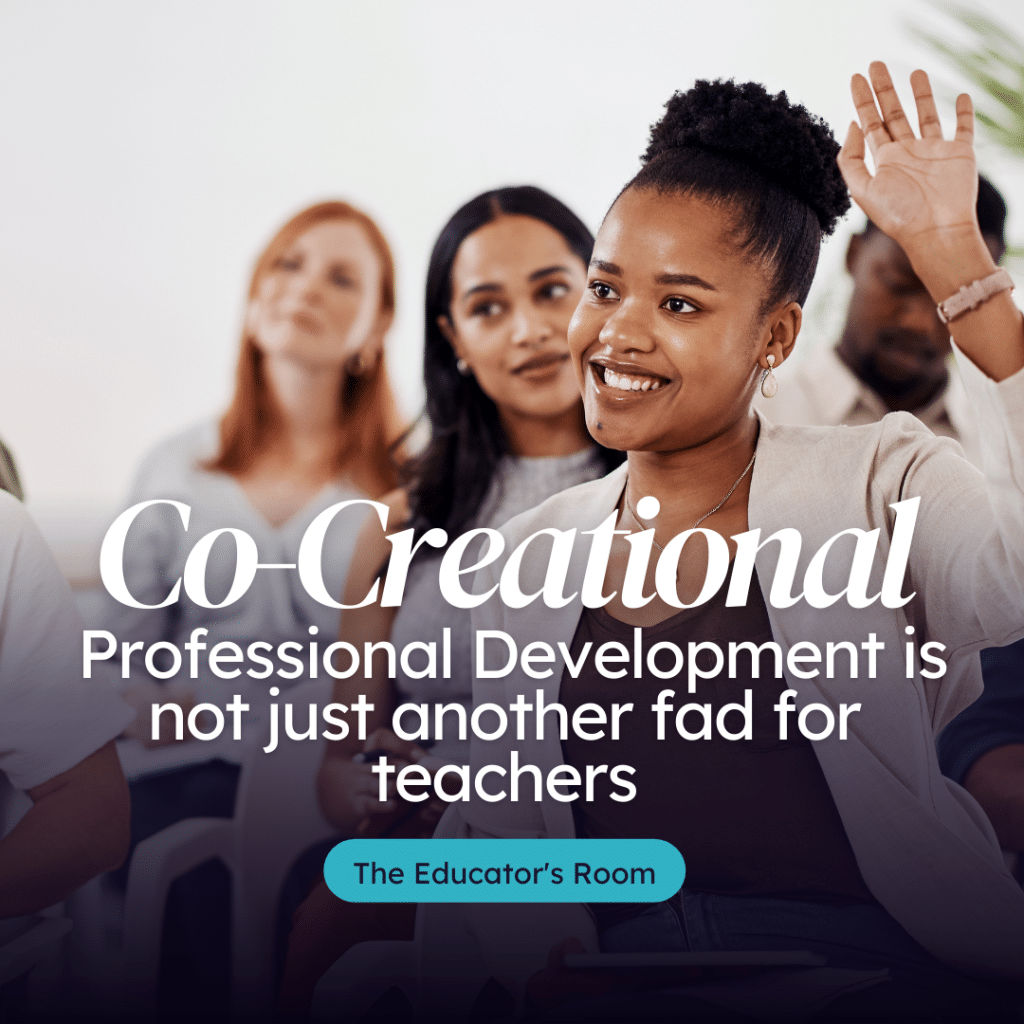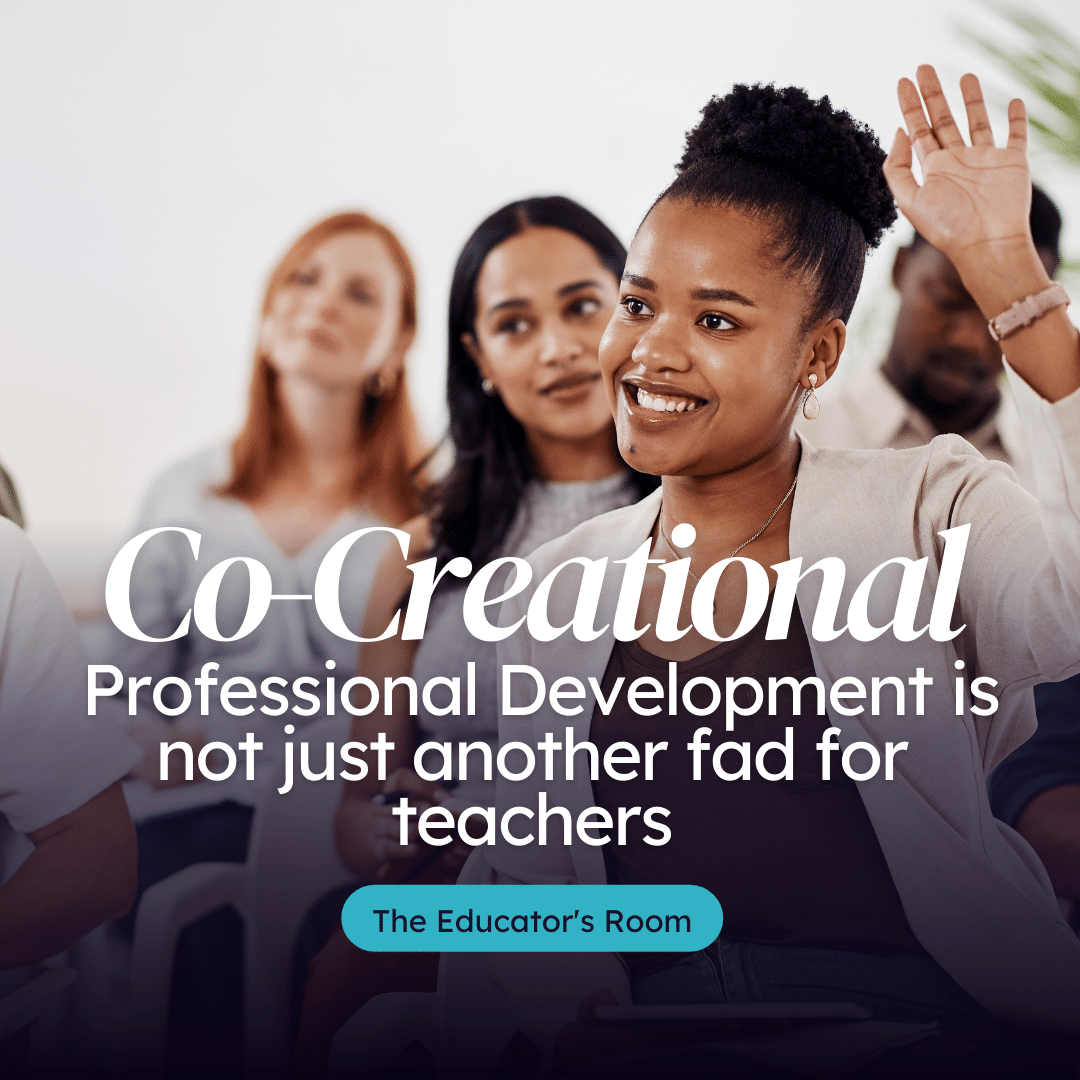When teachers are told they need professional development, it often creates negative emotions that are not addressed by leadership. To teachers, professional development is commonly seen as a time investment that does not address day-to-day job challenges.
Co-creational professional development presents a unique opportunity for teachers to have a voice in the creation of their professional development while opening doors to leadership opportunities. My research aimed to find opportunities to use shared leadership to empower systemically disempowered employees in professional development, and co-creational professional development was found to improve inclusivity to workers, foster deeper connections with colleagues, and provide workers a stake in their own professional development.
Traditional Professional Development and the paradox it creates for Administrators and Teachers
Professional development that is designed or chosen by leaders without worker input creates a paradox. On one side, you have administrators that need professional development to address the growth and learning of their employees; on the other side, you have the teachers that are often overworked and have little buy-in with traditional professional development. As a result, administrators’ and teachers’ needs are often not aligned.
Administrators have many complex challenges with assessing professional development results as they often do not know if their attempts at professional development are working. Many continue for years, even decades, to promote learning that has little-to-no effect on their employees. When they ask participants for feedback getting honest data on if the program increased their employee’s knowledge, they get mixed results. This is because many employees do not want to speak out and risk upsetting anyone in their workplace. Leaders may also not know how to adjust or select a professional development course to solve internal problems.
Paradoxically the people that can help solve the administrators’ problems with professional development are also the people they think need it. Administrators consistently ignore this fact as they are in positions of power and often do not want to share the power they have obtained. When Institutional norms are present as they are in educational institutions, there are structural power dynamics in play. Those in leadership positions primarily retain decision-making power, and these people tend to feel they have rightfully earned it.
Administrators need to think about their employees the right way, teachers have the ability and the knowledge to inform leaders on what topics should be addressed in professional development and the best time and duration the learning should be delivered.
Utilizing Professional Development
How do administrators solve internal problems utilizing professional development when there is little buy-in from the employees they are trying to teach?
To be successful, administrators need to understand better the people they are trying to teach. Low pay and large workload are looming in the background for many teachers. Teachers report working many additional unpaid hours to meet job responsibilities; and juggling complex tasks such as lecturing, grading, curriculum creation, and student communications while balancing feelings of a lack of appreciation.
Once administrators better understand their employees, they must look at their biases. Why not let others share in the power? What stops the administrators if their goal is to improve their department, improve student learning experiences, and have their employees learn authentically, passionately, and collaboratively? When employees are given the power to make decisions, they become authentic learners who feel welcomed to the table. When they feel their leaders have faith in them, they choose topics that align with the problems they experience in their classrooms without fear. Then something amazing happens; learning becomes more about growing. Who better to solve internal organizational issues than those experiencing them? Administrators need to have faith in their employees.
Once bias and egos are checked, then it is time to begin planning; providing a framework that is flexible is key
Once bias and egos are checked, then it is time to begin planning the professional development course. Co-creation can take many forms, but researchers have found ways to make shared leadership, namely co-creation, more successful. When it comes to co-creation in professional development, it is recommended to provide a loose framework so the participants have a guide to follow. The proposed co-creational professional development framework is cyclical and includes three main components: Inspiration, reflection, and co-creation.

Planning and Inspiration
In the first phase of co-created professional development, the group should choose a topic that inspires them. The topic should be based on an internal teaching problem or a teaching methodology they would like to use in their own classroom. Once a topic is selected then, a presenter should be chosen. This may take a bit of research. For example, the study’s topic was experiential learning, and the presenter was an expert who used experiential learning in their classroom.
Reflection
Next, the group meets for the first session, where they learn from the presenter. Once the first session is over, the group takes time for reflection. Reflection is vital to learning and should be set for a planned time in the professional development course. Reflection can come in many forms and should be an individual experience. The participants may choose to research the topic further or write about the topic. Reflection is very important because it gives the participants time to infuse their own culture into the learning and think of ways to connect their new learning with past ideas or future actions. Reflection aids in breaking through barriers that may be holding them back from using new learning,
Co-Creation
Lastly, the group plans and conducts a final meeting. This meeting is meant to be a time to discuss how to utilize their new learning, to co-create new ideas, and support each other socially as peers. The co-creational professional development study found that speaking about ideas helped the participants solidify newly learned thought processes.
Summary
Including the planning, the proposed co-creational professional framework is set up in four stages and is meant to be ongoing. Because of the cyclical nature, planning becomes easier over time; and as the group makes suggestions, gets to know each other, and completes the process, their own learning becomes more authentic. When teachers are given more power in their professional development, they can create leadership positions that can further their careers as well as help other schools and districts learn how to build and implement meaningful professional development. Co-creational professional development leads to better investments, gives better outcomes, and could support teacher retention.
Dr. Heather Emerson-Young is a part-time professor and a digital marketing strategist. She teaches at the University of Denver, Ocean County College, and Georgian Court University.







